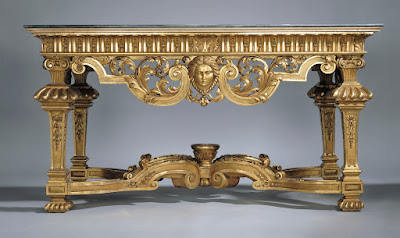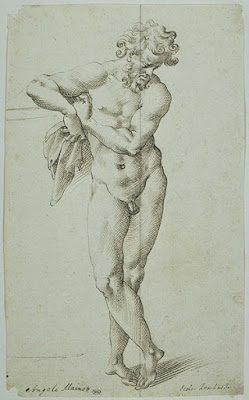 |
| Nicolas Poussin Sacraments I - Baptism 1637-40 oil on canvas National Gallery of Art, Washington DC (purchased from the Duke of Rutland) |
 |
| Anonymous copyist working in Rome after Nicolas Poussin Sacraments I - Baptism before 1784 watercolor and gouache on paper Musée du Louvre |
 |
| Nicolas Poussin Sacraments I - Confirmation 1637-40 oil on canvas Fitzwilliam Museum, Cambridge (on long-term loan from the Duke of Rutland) |
 |
| Anonymous copyist working in Rome after Nicolas Poussin Sacraments I - Confirmation before 1784 watercolor and gouache on paper Musée du Louvre |
 |
| Nicolas Poussin Sacraments I - Eucharist 1637-40 oil on canvas Fitzwilliam Museum, Cambridge (on long-term loan from the Duke of Rutland) |
 |
| Anonymous copyist working in Rome after Nicolas Poussin Sacraments I - Eucharist before 1784 watercolor and gouache on paper Musée du Louvre |
 |
| Nicolas Poussin Sacraments I - Extreme Unction 1637-40 oil on canvas Fitzwilliam Museum, Cambridge (purchased from the Duke of Rutland) |
 |
| Anonymous copyist working in Rome after Nicolas Poussin Sacraments I - Extreme Unction before 1784 watercolor and gouache on paper Musée du Louvre |
 |
| Nicolas Poussin Sacraments I - Marriage 1637-40 oil on canvas Fitzwilliam Museum, Cambridge (on long-term loan from the Duke of Rutland) |
 |
| Anonymous copyist working in Rome after Nicolas Poussin Sacraments I - Marriage before 1784 watercolor and gouache on paper Musée du Louvre |
 |
| Nicolas Poussin Sacraments I - Ordination 1637-40 oil on canvas Kimbell Art Museum, Fort Worth, Texas (purchased from the Duke of Rutland) |
 |
| Anonymous copyist working in Rome after Nicolas Poussin Sacraments I - Ordination before 1784 watercolor and gouache on paper Musée du Louvre |
 |
| Anonymous copyist working in Rome after Nicolas Poussin Sacraments I - Penance before 1784 watercolor and gouache on paper Musée du Louvre |
 |
| Nicolas Poussin St John baptising the People (not a component of the Sacrements series) ca. 1630-40 oil on canvas Getty Museum, Los Angeles (purchased indirectly from the Duke of Rutland) |
 |
| Anonymous copyist working in Rome after Nicolas Poussin St John baptising the People before 1784 watercolor and gouache on paper Musée du Louvre |
" . . . this Poussin is indeed a mighty eagle in his profession, or, to put it more clearly and without using metaphors, he is the most accomplished and perfect of all our modern painters. It is not difficult to convince scholars of this, men who study and judge matters in the manner of mathematicians, that is to say with precision, on the basis of pure demonstration, through analysis of the principles involved, and without allowing opinion or favour, which are the bane of truth, to intrude. Others, however, who have only a superficial knowledge, but yet have a very over-inflated view of their own judgment, will see this statement as a paradox, and in so doing render themselves incapable of ever being shown its truth. That is why I leave them to argue about it, and content myself with having established in this treatise the fundamental principles and the method by which it should be dissected, without involving myself any further in this dispute. I would only add by way of information that anyone who is curious enough to get to the stage of seeking decisive proof of Poussin's worth will find it amply demonstrated in his set of Seven Sacraments, which are to be seen in Paris at the residence of Monsieur Chantelou, a steward in ordinary to the King, and a close friend of this illustrious Poussin. [Chantelou owned, not the first set of Sacraments illustrated here, but the second set, in the same format, painted a few years later. Unlike the first set, so disastrously mishandled by the Rutland Estate, the second set is still intact, and currently on view at the National Gallery of Scotland in Edinburgh.] It is a series of seven uniform pictures, moderate in size, but of extraordinary diligence, in which this noble painter seems to have given us not only a perfect demonstration of the art in accordance with all the parts examined in this treatise, but also an illustration of the highest state of excellence which can be achieved, through his innovation and inventiveness, the nobility of his ideas on each subject, his scholarly and judicious observance of costume (in which he is almost unique), the force of his figures' expressions, and, in a word, all the same qualities discernible in the great geniuses of antiquity . . . "
– Roland Fréart de Chambray, from An Idea of the Perfection of Painting (1662), translated by Fabia Claris and Bridget Maison (1990)












































